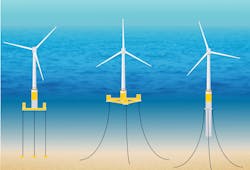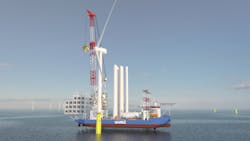Offshore Wind Energy
Floating Wind JIP launches technology competition
The Floating Wind joint industry project (JIP), managed by the Carbon Trust, has launched the Floating Wind Technology Acceleration Competition.
Formed in 2016, the Floating Wind JIP is a collaborative research and development initiative between the Carbon Trust, Scottish government, and 14 international offshore wind developers: EnBW, ENGIE, Eolfi, E.ON, Equinor, ScottishPower Renewables, innogy, Kyuden Mirai Energy, Ørsted, Shell, SSE, TEPCO, Vattenfall, and Wpd.
Funded by the Scottish government, the objective of the competition is to accelerate the development and de-risking of floating wind technology with a particular emphasis on mooring systems and operations and maintenance (O&M).
It is specifically seeking technologies to address four key challenge areas:
• Technologies that will enable effective and safe major component exchange offshore. For example, by compensating for the relative motion between the vessel and turbine during O&M.
• Developing cost-effective and safe disconnection and re-connection operations when turbine foundations are towed to port. This includes novel ‘out of service’ arrangements which ensure mooring lines and electrical array cables safely remain secured in-situ while the turbine is in port.
• New methods for cost-effective, safe, and reliable monitoring and inspection of large numbers of mooring lines, power cables, and foundation structures.
• New methods, materials, or technologies that reduce the cost of mooring systems through easier and safe installation and/or reduced maintenance requirements.
The deadline for applications is Nov. 5, 2019.
Moray East piling installation hits halfway point
Piling installation at the Moray East wind farm offshore the UK has reached the halfway point, according to DEME Offshore.
Having started offshore construction works with the jackup installation vessel Apollo in May 2019, more than 156 pin piles out of 309 have been installed.
The piles are part of the jacket-based foundations on which the turbines will later be installed.
The company said positional accuracy has been achieved with its patented piling template, which integrates with the jackup legs of the Apollo.
Subject to the weather and any other operational conditions, the remaining piling operations are expected to be completed by the end of 2019, in readiness for jacket installation works in 2020.
Work gets under way on wind farm offshore Belgium
DEME says its installation vessel Innovation will soon set sail to the Belgian North Sea with the first load of 58 turbine foundations and transition pieces for installation at the SeaMade offshore wind farm.
Currently, the first monopiles and transition pieces are being loaded at SIF’s Maasvlakte terminal in Rotterdam.
With a 487-MW capacity, SeaMade is said to be the largest offshore wind farm in Belgium. SeaMade stands for a combination of two offshore wind projects, previously known as Mermaid (235 MW) and Seastar (252 MW).
DEME’s scope includes the installation of the 58 foundations and all inter-array cables, two offshore substations, and the 220-kV submarine high voltage cable.
In spring 2020, the 8.4 MW turbines are expected to be installed on the foundations.
Before the end of 2020, SeaMade is expected to provide renewable energy to 500,000 households in Belgium, the company said.
NOV wins package and design order
National Oilwell Varco Inc. (NOV) says it has been awarded equipment package and design orders for one of the world’s largest offshore wind turbine installation vessels by Japanese-based Shimizu Corp.
NOV, through its subsidiary GustoMSC, has worked closely with Shimizu on the customized jackup design which has a total tonnage of 28,000 t and is capable of accommodating 130 people. The vessel will also incorporate a proprietary 2,500 t telescopic leg crane designed specifically for the offshore wind market to provide a combination of high elevation hoisting capability for turbine installation and heavy load capability for foundation installation. Japan Marine United shipyard will build the unit.
Planning is under way in Japan for a total of 9 GW of offshore wind farm generation capacity using a new generation of larger, more economically efficient, ultra-large-scale wind turbines of 9 to 12 MW in size. Delivery of this vessel, which will be the largest in the region, is expected in late 2022. •

